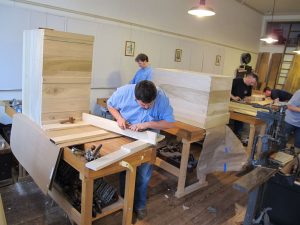We may receive a commission when you use our affiliate links. However, this does not impact our recommendations.
Building the shell and lid of a traditional, full-size and fully dovetailed tool chest in five days is a challenge. Which is likely why there aren’t a lot of classes offered on the topic.
But like Pandora’s Box, something happens when you open the lid to this chest.
Yes, it’s just a box filled with tools, but as I’ve traveled with this chest for the last year I’ve offered all my students an invitation to use all the tools in my chest. As they start to work with the chest, I see them falling into the same rhythms that I do.
The result? They have the same results that I do – fewer tools scattered on the bench and more of them easier to find in the trays in the chest. That might seem an insignificant benefit, but when you are trying – sometimes desperately – to build a huge tool chest in five days, every hand motion counts.
On Friday we wrapped up the class. It was frantic, as opposed to the maudlin hugs and teary good-byes that I prefer. At 5 p.m. I loaded up the chest into my wife’s CRV (yes, the process looked like a quickie Oompa Loompa funeral) and hit the road for Atlanta with heavy rains headed toward The Woodwright’s School.
The above video shows the activities of the last day of the class.
When I got to Atlanta to teach a couple days here at the Woodcraft store, I invited the 10 students to use any of the tools in my chest. And the result?
— Christopher Schwarz
P.S. You can view the other four days of class activity here: Day 1, Day 2, Day 3, Day 4. The chest is featured in “The Anarchist’s Tool Chest,” available at shopwoodworking.com.
Here are some supplies and tools we find essential in our everyday work around the shop. We may receive a commission from sales referred by our links; however, we have carefully selected these products for their usefulness and quality.











These manually operated mortisers are interesting. I need to find out more.
Your classes always seems like an awesome time. How can I get in one?
That mortiser kind of illustrates my problem with handwork/tradtional work. I enjoy handwork and also use power tools. Sometimes I chop mortises by hand, sometimes I use my router table being that I don’t own a mortiser. It would be great to do it with tradtional machinery but unless I spend the next 3 years worth of weekends at garage sales and flea markets I won’t have access to most of that equipment. And if I do manage to find some on the open market I would probably have to spend another 6 months in the restoration process. So as much as I would like to be a true traditional woodworker it’s pretty difficult when you can’t get to the equipment.
Can you give me some history on these manually operated mortisers? Or maybe the provenance of this particular one. Who made them, and where would I look for one or are they too rare to find?
Maybe the class at Kelly’s should be 6 days so we have time for the teary maudlin goodbyes!
Can anyone shed some light on the details of that mortiser?
So that’s how that mortiser should work! We have a prototype of one like that where I volunteer in the summer and I have not been able to get it to work at all because it is very top heavy. Stepping on the foot pedal makes the whole thing topple towards the user. Considering the amount of cast iron in it that is not a pleasing prospect. I wonder if the saw kerfs are necessary to get it chopping because the pressure needed to chop without them is immense. I need to spend some time on it this summer to see if I can get it working smoothly like Roy’s version.
Maybe you could take the route of some chairmaking classes, and have the students come in to find pre-dovetailed chests — they just swab on the hide glue and start clamping up. (Or not!) I hope your students get the message that building the chest is the start of a journey that involves things like moulding planes, dividers, and all sorts of other strange tools and blogs. Al least that’s what I’m finding.